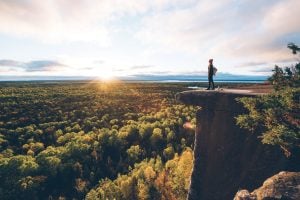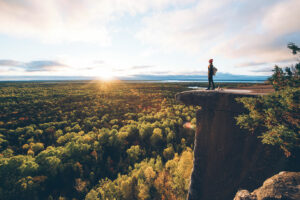
Travel
How to stop a gold rush
The new movement building flourishing tourism hubs across Canada – one sustainable example at a time
- 3297 words
- 14 minutes
Travel
Friendly locals, tide-to-table seafood and some of the best fishing in Florida. Why Destin should be your next stop along the Florida Panhandle

I should have packed my ski goggles.
It’s a ridiculous thought to have in the Florida Panhandle, where temperatures can reach 20 degrees Celsius even in the fall and winter. Still, it pops into my head as I squint at the sweeping white dunes that descend to the emerald coastline. The sun and sand interweave to form a bright glare reminiscent of ski runs back home in Canada, and I can’t help but chuckle as I realize I’m subconsciously searching for trail markers amid a sea of radiant white. I learned later that the brightness of the sand is due to ground quartz deposits from the Appalachian Mountains, which are highly reflective, hence my immediate vampire-like need for protective eyewear.
As I step off the ramp of the boat shuttle, my feet vanish into the sugary sand with a soft scrunch. Unlike the stiffness of matted snow, these grains are so fine they spill onto the insoles of my Teva sandals, and with each step, I feel like I’m simultaneously floating and sinking into a powdery abyss. The beach I’ve arrived at – adjacent to my hotel, the Emerald Grande – is completely deserted, save for a handful of vibrant orange butterflies and dozens of shorebirds pecking at whatever the ocean has swept to the coast.


This is my first real “welcome” to Destin – a small city nestled in the northwestern portion of Florida, hugging the Gulf of Mexico. Though my plane landed late the night before, I woke up at dawn this sunny November morning, bright-eyed and bound to catch the first boat shuttle of the day. I’ve never travelled solo before, and though I’ll soon meet up with a group of fellow travel writers, I feel the adrenaline rush of being alone in a place where I don’t know anyone.
In the meantime, I seek comfort in familiar things. A bird lover, I audibly gasp when I accidentally make eye contact with a great blue heron perched on a rocky jetty a mere two metres away. As I quietly scramble to change my camera lens before she dashes away, I realize how nonchalant she is about my presence – something I could have only dreamed of during my canoe trips in Ontario’s Algonquin Park. However, it isn’t just this bird who seems indifferent to my proximity; the hundreds of other herons and pelicans I encounter afterwards along the beach or within the city’s harbour appear to be as entrenched in the town as statues.
Like the waterfowl, the people of Destin fit into the town like perfectly placed pieces in a Panhandle puzzle – each with their own purpose. To understand the community’s dynamic, it helps to note that the area started as a small fishing village in the late 19th century and was built around what is now known as the Destin Harbour. More than 150 years later, it’s evident the harbour remains the town’s backbone, providing a means for many locals to support their families. Just as cooperation and unity were essential to the fishing fleet’s survival back then, this sense of harmony and warmth continues in the community today.
As I walk the long dock that wraps around the harbourfront later that morning, there isn’t a fisherman who doesn’t greet his fellow anglers with a toothy grin. To my right, I see men scaling and gutting baskets of snapper, surrounded by supportive, beer-toting onlookers who give the occasional nod of approval. And as I round a building to continue my stroll along the harbour, a man practically jumps out of the way to let me pass. “Ma’am,” he says politely, motioning his arm along the boardwalk. At that moment, I feel so welcome that I nearly forget I’m 2,000 kilometres away from home.


You wouldn’t know it based on the humility of the locals, but the town has gained global fame for its annual month-long fishing tournament: the Destin Fishing Rodeo. Every October since 1948, over 30,000 saltwater anglers of all ages flock to Destin in hopes of finding their name on the leaderboard for heaviest catch. Known as “The World’s Luckiest Fishing Village,” the town’s coastal waters boast the widest variety of fish species in the area, from marlin to sailfish. This is thanks to its sheer drop-offs and underwater cliffs, which allow bigger fish to swim to shallower depths, as I learn while touring The Destin History & Fishing Museum.
Although prizes used to consist of such things as a six-pack of beer and a windshield wiper, the Rodeo reward has since evolved to include thousands of dollars in cash, pier passes and merchandise, bringing upwards of $10 million in tourism annually. “It really put Destin on the map,” says Vivienne Williams, the museum’s associate director.
The fishing tournament has also become synonymous with Bruce Cheves, also known as Bruce the Weighmaster, who coined the catchphrase “Bring me a fish, and I’ll make you famous.” The charismatic 71-year-old has long been the voice of Destin’s fishing community, weighing all the fish at the Rodeo since 1991. The city adores him so much that in 2010, they declared Oct. 16 “Bruce Cheves Day.” I can’t help but feel star-struck when I run into him along the harbour the following day. He has a scruffy white beard, rough skin, a thick Southern accent and an appreciation for profanity. As he animatedly recounts a story about the time he jumped out of a burning boat, I can see why the locals love him. Though I am a stranger to him, his engaging personality makes me feel like we’re old friends.
The opportunities to fish in Destin are undoubtedly impressive, and, of course, so are Bruce’s stories. But as a non-fisherman, I am just as impressed by the endless opportunities to indulge in seafood. Soon after learning about lionfish, an invasive species in the Gulf with spines that can deliver a painful sting, I was pleasantly surprised to discover that lionfish in filleted form is, in fact, to die for. Presented on individual seaweed beds at East Pass Seafood & Oyster House, the tender, buttery, safe-to-eat appetizer breaks apart in my mouth effortlessly. If the taste wasn’t enough to satisfy me tremendously, I was pleased to learn that ordering lionfish creates a higher demand for them and helps reduce their impact on Destin’s native aquatic species.
Over my three days in Destin, I consume more tide-to-table seafood than I would previously have thought imaginable. Every bite of grouper, snapper, oyster, shrimp or crab is fresh and succulent, as if they had sprung out of the ocean and catapulted themselves straight onto my plate. In reality, these delectable dishes are the product of ardent fishermen, chefs and restaurant owners who dedicate their lives to the craft.


If the harbour is the backbone of Destin, the people are its heart — as evidenced by my meal at Boathouse Oyster Bar, a small restaurant resting on a dock overlooking Destin Harbour. Sprawled on the edge of a wooden stage is a tabby cat named Tortuga, who has lived at the establishment for 14 years. Like the herons scattered around the harbour, she lies as still as a statue, snoozing blissfully in the sun.
After consuming a dozen oysters, I prepare to head back to the beach. Before I can stand up, a chef hurries out of the kitchen with a bowl of freshly made apple cinnamon bread pudding – a southern staple – and asks if I’d like a taste. “I just made it,” he says, refusing to accept any additional money. I graciously eat the dessert, feeling the warmth from the bread pudding and his hospitality.
The restaurant’s interior is decorated with hundreds of dollar bills stapled to every square inch of wall and signed by customers from all over the country. I’m in a time capsule; some of the yellow, wrinkly bills are undoubtedly from a different decade. Wanting to be part of this ongoing record, I grab a bill, sign my name, and proudly staple it to the bar. Though I will soon travel 2,000 kilometres away from here, where the sun reflects off mounds of glistening snow rather than sand, I have a long list of reasons to come back.




Are you passionate about Canadian geography?
You can support Canadian Geographic in 3 ways:

Travel
The new movement building flourishing tourism hubs across Canada – one sustainable example at a time

Travel
Where to stay, what to do and how to make the most out of your time in Costa Navarino

Travel
Un nouveau mouvement créateur de pôles touristiques florissants dans tout le Canada – la durabilité, un exemple à la fois

People & Culture
A moratorium on cod fishing that was supposed to last two years has now lasted 30. What will it take to rebuild cod stocks — and a way of life?